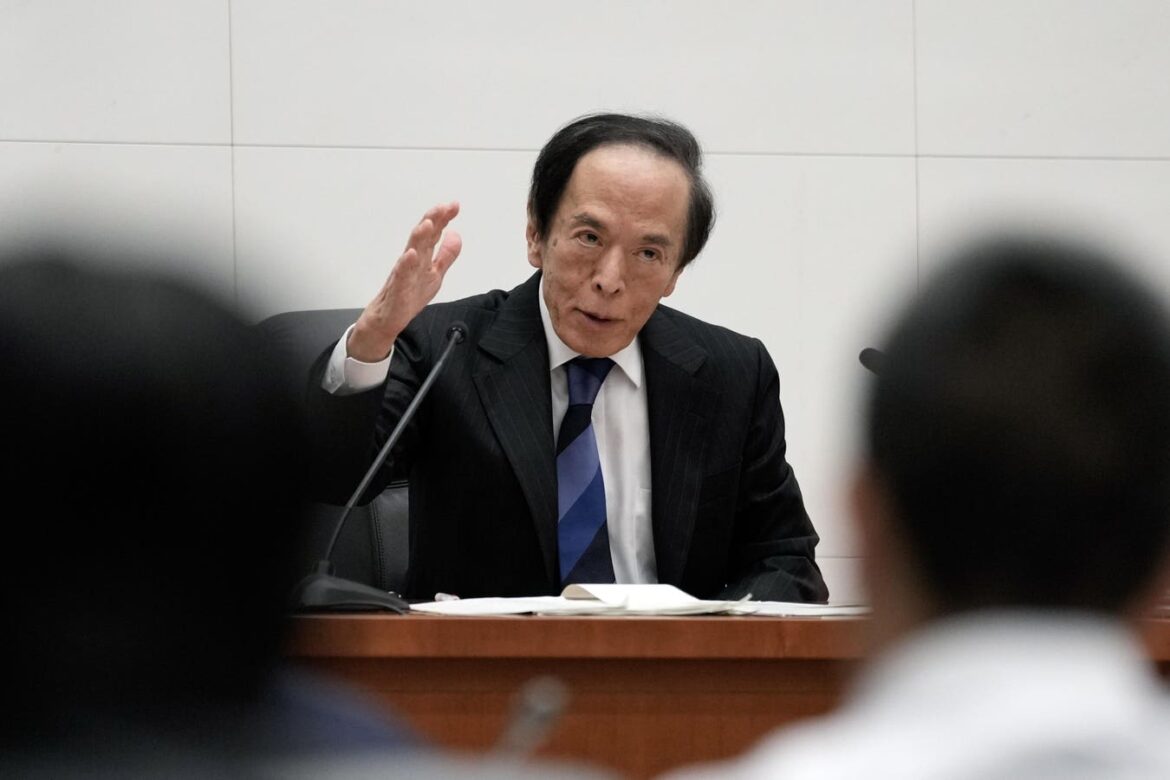Kazuo Ueda, governor of the Bank of Japan (BOJ), speaks during a news conference at the central bank’s headquarters in Tokyo, Japan.
Toru Hanai/Bloomberg
On any list of central bankers dying to get off this crazy thing called 2025, Japan’s Kazuo Ueda deserves a spot at the very top.
Sure, Jerome Powell has an argument that he’s having a worse year as Donald Trump threatens to fire him. This week, the Federal Reserve chair even found himself donning a hard hat with Trump as the president stopped by Fed headquarters on a tour of sorts.
But the economic script is writing itself for Fed decision-making. Any argument that the Fed should be cutting rates is based on loyalty to Trump World, not economics. With core inflation rising at a 2.9% annual rate and tariffs likely to raise costs further, easing now might just troll the “bond vigilantes” into boosting U.S. Treasury yields anyway.
The call Ueda’s team in Tokyo will make at the July 30-31 policy meeting is altogether more difficult. Virtually every serious BOJ watcher sees Ueda & Co. standing pat next week. But the BOJ is probably itching to hike rates 25 basis points to 0.75% to let the markets know its “normalization” strategy remains alive and well.
Ueda has every reason to worry that the BOJ is now at the same fork in the road as it was in 2007, the last time the central bank managed to hike rates to today’s 0.5% level. By 2008, in the aftermath of the “Lehman shock,” the BOJ was reversing course. Rates were soon back at zero. Also back was the quantitative easing strategy the BOJ thought it had put to rest.
Will Ueda also have to reverse his rate hikes since July 2024? It’s a very open question, particularly with Japan agreeing to a tariff deal with Trump. Clearly, Japan facing a 15% Trump tax — not the 35% it might have — is good news. Ditto for Japanese auto exporters escaping the earlier 25% tariff rate.
But Japan’s economy contracted 0.2% in the first quarter even before the main tariffs were imposed. The second quarter was hit by a triple whammy of tariffs, domestic inflation and sudden spikes in bond yields that made banner headlines.
As the third quarter begins, Japan isn’t exactly firing on all cylinders. China is slowing and exporting deflation, while neither the U.S. nor Europe is booming to juice Japanese exports. Japan’s inflation troubles are pushing it into stagflationary territory.
How the Ueda BOJ should play the months ahead is anyone’s guess. That includes Ueda, as Tokyo politics veers into an unusually tumultuous period, thanks largely to high inflation.
In the July 20 election, the ruling Liberal Democratic Party lost control of Japan’s upper house. It means the party that’s led Japan with only two brief interruptions since 1955 controls neither house of parliament directly. It must now cobble together a coalition to lead the nation. And Prime Minister Shigeru Ishiba is likely to resign in short order to take responsibility.
The price for that partnership is likely to be lower taxes, a risk that’s unnerving the bond market. One policy success Ishiba has had, arguably, is avoiding huge budget-busting stimulus packages. That’s about to change, further swelling Japan’s already crushing debt load.
Last week, an auction of 40-year Japanese government bonds (JGBs) attracted the weakest demand since 2011. In mid-May, a routine sale of $6.9 billion of 20-year bonds yielded some of the worst numbers since 1987. The “tail,” the gap between the average and lowest-accepted prices, was the worst in 38 years.
It’s never good to see #JGBCrash trending on social media. If the BOJ were to raise rates as Ishiba’s party is adding to the national debt, Japanese borrowing costs might skyrocket and increase recession risks.
Of course, if Ueda goes easy on inflation and prices stay well above the BOJ’s 2% target, the BOJ might only have to tighten more aggressively in the later months of 2025 and into 2026.
As Ueda tries to make sense of things, one thing is clear: 2025 can’t end fast enough for this BOJ team.


AloJapan.com